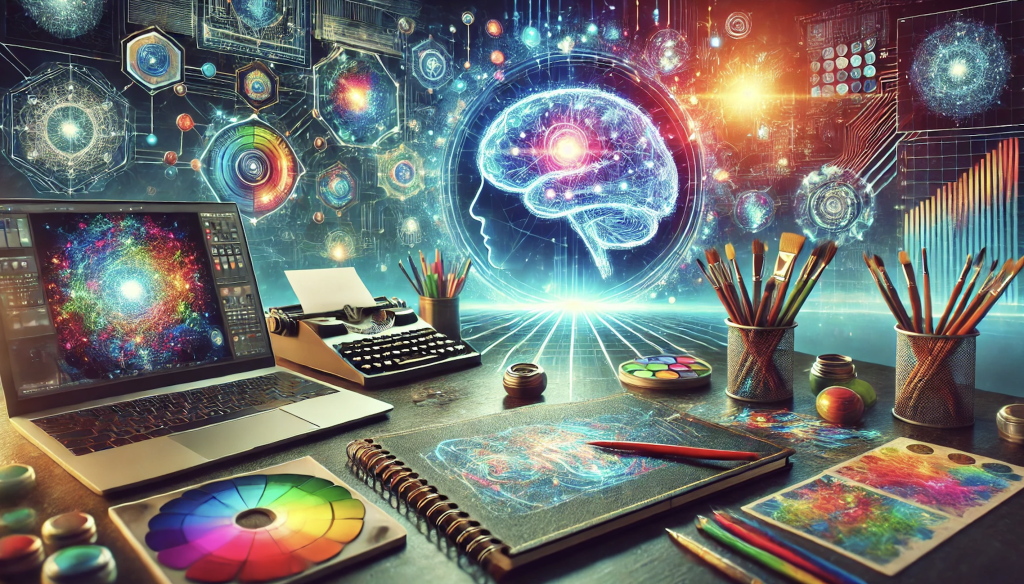In today’s world, where anyone with a smartphone and AI tools can create professional-grade visuals in minutes, the barriers to graphic design have never been lower. The rapid evolution of artificial intelligence has transformed the creative process, making it faster, more accessible, and incredibly efficient. With a few clicks, thoughts can be transformed into polished visual assets, giving individuals unprecedented power to create.
But true design isn’t about how fast you can generate an image or how accessible the tools are—it’s about the depth of thought behind every decision. At its core, design is a process of problem-solving, strategic alignment, and continuous improvement. It’s about using creativity and logic together to build brands that solve real problems and thrive in an ever-changing world.
At Bl3nd Design, we believe that while tools like AI accelerate the creative process, the essence of design lies in how deeply you can think. It’s not just about creating visuals—it’s about crafting solutions that align with goals, adapt to change, and drive real impact. The tools are powerful, but the vision is what makes design truly transformative.
Design as a Strategic Process
True design is never random or purely aesthetic. While beauty and visual appeal are important, great design serves a purpose: it solves problems, drives results, and aligns with specific business goals. Every element in a design—from the choice of colors to the layout and typography—must contribute to the overall strategy.
Here’s what makes the design process strategic:
- Problem Definition: The foundation of good design starts with asking the right questions. What problem is the design solving? What is the intended outcome? Who is the target audience?
- Alignment with Business Objectives: Effective design is deeply connected to business strategy. It should reflect key goals such as increasing brand awareness, driving sales, or improving user engagement.
- Data-Informed Decision Making: True design is objective and grounded in facts. Relying on analytics, user research, and behavioral insights ensures that design decisions are purposeful and effective.
- Iterative Refinement: The best designs aren’t created in a single pass. They are honed through a process of testing, feedback, and continuous improvement to achieve the best results.
- Consistency Across Platforms: In an interconnected world, brands must maintain a cohesive identity across all channels, from websites to social media to print materials.
This strategic foundation ensures that design isn’t just visually compelling—it’s impactful and measurable.
Cognitive Speed and the New Role of Designers
With AI tools accelerating the creation process, the role of the designer has evolved. The challenge is no longer about mastering technical tools or meeting production deadlines. Instead, the real bottleneck lies in the designer’s ability to think critically, process information quickly, and articulate their ideas effectively.
Key skills for designers in this new era include:
- Rapid Ideation: Generating multiple concepts quickly and choosing the ones that best align with the project’s goals.
- Clarity of Articulation: Translating abstract ideas into actionable concepts that resonate with stakeholders and audiences alike.
- Cross-Disciplinary Thinking: Understanding not just design but also marketing, psychology, business strategy, and consumer behavior to create solutions that work holistically.
- Feedback Integration: Adapting quickly to input and using it to refine designs without losing sight of the overall vision.
- Long-Term Vision: Designing with scalability and evolution in mind, anticipating future changes in the market or brand trajectory.
AI has removed many technical barriers, but the designer’s role is now more intellectual and strategic than ever. It’s about using tools not just to create but to think better and faster.
Why Design Must Be Logical, Not Emotional
One of the greatest misconceptions about design is that it’s primarily an emotional or subjective endeavor. While it’s true that good design often evokes emotion in its audience, the process of creating it must be rooted in logic, data, and strategy. Emotional decision-making can lead to designs that are inconsistent, misaligned with business goals, or disconnected from the target audience.
Logical design, on the other hand, is:
- Objective: Every choice—whether it’s a color palette, font, or layout—is supported by data, insights, or proven principles.
- Focused on Results: Designs are evaluated based on their performance, such as increased engagement, better conversion rates, or improved brand recall.
- Timeless and Adaptable: Logical design systems are built to last and evolve, avoiding trends that may quickly fade.
- Aligned with User Needs: The audience’s preferences and behaviors are prioritized over personal taste or internal opinions.
- Systematic: A consistent framework ensures that all design elements work together harmoniously across different contexts.
At Bl3nd Design, we remove emotion from the decision-making process. Instead, we focus on creating systems and solutions that drive measurable success while maintaining the flexibility to adapt over time.
The Importance of Brand Evolution
A brand is not a static entity—it’s a living, breathing representation of a business that evolves alongside its market, audience, and competitors. In today’s dynamic environment, brands that fail to adapt risk becoming irrelevant. Design systems should be built with evolution in mind, ensuring that logos, marketing materials, and digital assets can grow and change as needed.
Key considerations for brand evolution include:
- Regular Audits: Periodically assessing visual identity to ensure it aligns with current business goals and market trends.
- Modular Design Systems: Creating assets that are flexible and can be updated easily without losing their core identity.
- Future-Proofing: Anticipating technological and cultural shifts to ensure that designs remain relevant in the long term.
- Consumer-Centric Adjustments: Adapting to changes in consumer behavior, preferences, and expectations.
- Scalable Assets: Ensuring that all design elements can work across various platforms and mediums, from print to digital to experiential.
This commitment to evolution ensures that brands not only survive but thrive in a competitive and ever-changing landscape.
How AI Enhances, Not Replaces, Design
AI has democratized design, making professional-quality tools available to everyone. But while AI can generate visuals, it cannot replace the human element of design—the strategy, empathy, and critical thinking that drive true innovation. Instead of diminishing the designer’s role, AI elevates it by automating mundane tasks and enabling greater focus on creative and strategic aspects.
Here’s how AI enhances the design process:
- Faster Prototyping: Designers can experiment with multiple concepts in minutes rather than hours.
- Enhanced Efficiency: Repetitive tasks like resizing, file formatting, and versioning are streamlined.
- Inspiration and Exploration: AI can suggest new ideas or styles that designers might not have considered.
- Data Integration: Tools that analyze user behavior and performance metrics help designers make informed decisions.
- Customization at Scale: AI allows for hyper-personalized designs tailored to individual audience segments.
At Bl3nd Design, we see AI as an invaluable partner in the creative process, freeing us to focus on the deeper work of solving problems and crafting meaningful solutions.
Design Is Only as Good as the Thinking Behind It
The barriers to graphic design and visual communication have never been lower, thanks to advancements in AI and technology. But the essence of true design remains the same—it is a process of logical problem-solving, strategic alignment, and iterative improvement. The tools may change, but the thinking that drives great design will always be the most critical factor.
At Bl3nd Design, we believe in creating systems and solutions that are rooted in strategy, informed by data, and designed to evolve. By combining the power of AI with human insight and creativity, we help our clients build brands that are not only visually compelling but also impactful, adaptive, and aligned with their long-term goals.
Design isn’t about how fast you can create—it’s about how deeply you can think. Let us help you bring your vision to life with clarity, purpose, and innovation.
The Best AI Tools for Cognitive Design
AI is transforming design by enhancing creativity, optimizing workflows, and reducing costs. Below are the top tools categorized by their applications in text, images, video, code, data, task automation, and other use cases, listed in an easy to understand manner for immediate use in your business.
Text Writing and Analysis
ChatGPT: Generates ideas, drafts marketing copy, and automates customer communication for enhanced productivity.
Jasper AI: Specializes in SEO-optimized content and branded marketing materials.
Perplexity AI: Research-focused AI providing structured, cited answers for business use.
Quillbot: Paraphrases and summarizes text efficiently, saving time on content editing.
Writer.com: AI tool focused on ensuring brand voice consistency across all written communication.
Image and Graphic Creation and Analysis
Adobe Firefly: Professional-grade generative AI for creating and editing images seamlessly.
Canva’s Magic Studio: User-friendly graphic design platform with AI-powered templates.
DeepAI: Offers custom image generation and enhancement for various creative industries.
Fotor: AI-powered photo editing and enhancement tool for businesses.
Midjourney: Produces unique, high-quality visuals based on detailed text prompts.
Video Creation and Analysis
Fliki: Converts text into engaging video content, ideal for social media marketing.
NVIDIA App: Enhances video production quality with real-time rendering and AI-driven effects.
Pictory: Automatically generates short-form videos from long-form content like webinars or blogs.
Runway AI: Automates video editing and creates visually stunning special effects.
Synthesia: Creates professional videos featuring AI avatars, perfect for training and corporate presentations.
Code and Programming Creation and Analysis
CodeWhisperer: AI-powered coding assistant that integrates seamlessly with AWS for development.
Blackbox AI: Simplifies debugging and enhances coding workflows for faster results.
GitHub Copilot: Suggests code snippets and autocompletes tasks to accelerate development.
Replit Ghostwriter: Provides AI-driven code suggestions and debugging assistance to streamline workflows.
Tabnine: AI-powered tool offering intelligent code completions for enterprise-grade development.
Data and Analytics Creation and Analysis
BigQuery: Scalable analytics platform offering predictive insights for businesses.
IBM Watson Analytics: Advanced tool providing predictive analytics and natural language insights.
Microsoft Power BI: Visualizes complex data into actionable insights for better decision-making.
Tableau AI: Transforms raw data into interactive, real-time visualizations for stakeholders.
Zoho Analytics: AI-powered business intelligence tool that simplifies reporting and analytics.
Task and Workflow Automations
Asana AI: Optimizes task prioritization and streamlines project alignment for teams.
ClickUp AI: Automates workflow management by tracking projects and prioritizing tasks.
Notion AI: Enhances task management with AI-driven insights and organizational tools.
UiPath: Automates repetitive back-office processes with advanced robotic process automation.
Zapier: Connects apps and automates workflows to eliminate repetitive tasks.
Other Use Cases
Beautiful.ai: Automates the design of visually appealing presentations for businesses.
Descript: Simplifies video and podcast editing with transcription and AI-enhanced tools.
Luma AI: Creates realistic 3D assets for AR/VR applications and product visualizations.
Stable Diffusion: Open-source tool for image generation, ideal for creative experimentation.
Writerly AI: Focused on creating brand-aligned content for marketing campaigns and copywriting.





















